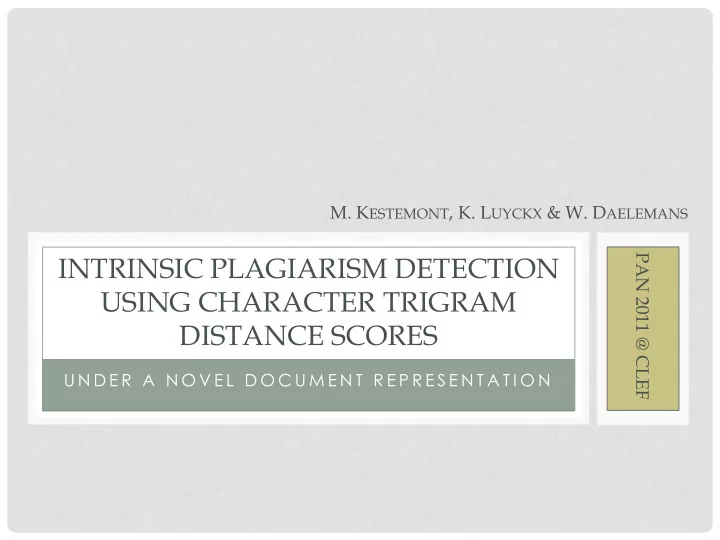

M. K ESTEMONT , K. L UYCKX & W. D AELEMANS INTRINSIC PLAGIARISM DETECTION PAN 2011 @ CLEF USING CHARACTER TRIGRAM DISTANCE SCORES U N D E R A N O V E L D O C U M E N T R E P R E S E N T A T I O N
PLAGIARISM DETECTION • External detection: • reference corpus = ALL source documents • ‘ Closed ’ world • Realistic? • Growing potential reference collection (cf. web) • Computationally complex! • Not all sources digitally/publicly available • E.g. student hiring ghost writer for sections in master thesis: what if ghost writer himself did not plagiarize? • Practically relevant
APPROACH? • Limited resources • Only document itself… • Seminal work: standard methodology “The underlying approach to intrinsic plagiarism detection has not changed: a suspicious document d is chunked, and […] each chunk is compared with the whole of d . Then, chunks whose writing style differs significantly from the average writing style of the document are identified using outlier detection.” (PAN overview 2010) • (Negative undertone?)
Segments, chunks, windows, … Suspicious document Window size W 1 W 2 W 3 Step size
D vs. w 1 , w 2 , w 3 , …, w n Entire suspicious document D Δ (D, w i ) W 3 W 1 W 2 W 4
BEST-CASE SCENARIO
IMPLICIT ASSUMPTIONS? 1 – “It’s okay to compare a chunk to the document as a whole.” 2 – “The whole document is a reliable point of stylistic reference.”
COMMON PRACTICE? Equal size Different size
IMPLICIT ASSUMPTIONS? 1 – “It’s okay to compare a chunk to the document as a whole.” 2 – “The whole document is a reliable point of stylistic reference.”
WORST-CASE SCENARIOS Original text will be marked as plagiarized? Which one is the original author?
QUESTIONABLE ASSUMPTIONS 1 – “It’s ok to compare a chunk to the document as a whole” 2 – “Whole document is reliable point of stylistic reference” But is there an alternative?
WINDOW VS. WINDOW • Instead of Document vs. Window … • Window versus Window • No assumption of reliability of D as a whole • Comparing blocks of equal size
SYMMETRICAL DISTANCE MATRIX Cf. Distance tables for clustering
CLUSTERING OF PLAGIARISMS OF SAME SOURCE
DISTANCE MEASURE • Stamatatos’s normalized distance • Distance between two ‘text profiles’ • Profile = bag-of-character-trigrams
SYMMETRIC ADAPTATION • Originally: all trigrams from 1 document • Asymmetrical: distance(A,B) != distance(B,A) • Adaptation: restrict to n =1000 most frequent character trigrams from entire corpus • Stylometric inspiration • Computationally simple: symmetry!
OUTLIERS? • Distance table (cf. clustering) • Multivariate, higher-dimensional • Mvoutlier ( R , Filzmoser et al.) • Principal Components Analysis • Reduces dimensionality before detection
CHUNKING? The smaller the windows, the better (but more expensive)
OUTBOUND PARAMETER - Controlled ratio of outliers detected - Higher outbound pushed precision - Lower outbound pushed recall (even more)
RESULTS Training corpus (PAN 2010) Test corpus (PAN 2011-INTR) • Plagdet: 16.79 (2 nd place) • Plagdet: 28.60 • Recall: 36.57 • Recall: 42.79 (!) • Precision: 26.70 • Precision: 10.75 (?) • Granularity: 1.11 • Granularity: 1.03 Comparison • ws = 5000, ss = 2500, n = 2500, outbound = .20 • Disappointing precision – dramatic drop • Method does invariably great in recall • Shorter documents in test?
REFERENCES Filzmoser, P. ,Maronna, R. ,Werner, M. (2008). Outlier identification in high dimensions. • Computational Statistics and Data Analysis 52(3). Potthast, M., Barrón Cedeño, A., Eiselt, A. ,Stein, B., Rosso, P. (2010). Overview of the 2nd • International Competition on Plagiarism Detection. Notebook Papers of CLEF 2010 LABs and Workshops. Stamatatos, E. (2009). A Survey of Modern Authorship Attribution Methods. Journal of the • American Society for Information Science and Technology 60(3). Stamatatos, E . (2009). Intrinsic Plagiarism Detection Using Character Ngram Profiles. • Proceedings of the 3rd International Workshop on Uncovering Plagiarism, Authorship, and Social Software Misuse (2009) Stein, B., Lipka, N., Prettenhoffer, P. (2011). Intrinsic Plagiarism Analysis. Natural Language • Engineering 45(1). Luyckx, K., Daelemans, W. (2011). The effect of author set size and data size in authorship • attribution. Literary and Linguistic Computing 26(1).
Recommend
More recommend